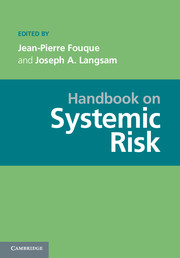Book contents
- Frontmatter
- Contents
- Contributors
- Introduction
- PART I DATA: THE PREREQUISITE FOR MANAGING SYSTEMIC RISK
- PART II STATISTICS AND SYSTEMIC RISK
- PART III MEASURING AND REGULATING SYSTEMIC RISK
- PART IV NETWORKS
- PART V SYSTEMIC RISK ANDMATHEMATICAL FINANCE
- PART VI COUNTERPARTY RISK AND SYSTEMIC RISK
- 19 Pricing and Mitigation of Counterparty Credit Exposures
- 20 Counterparty Contagion in Context: Contributions to Systemic Risk
- PART VII ALGORITHMIC TRADING
- PART VIII BEHAVIORAL FINANCE: THE PSYCHOLOGICAL DIMENSION OF SYSTEMIC RISK
- PART IX REGULATION
- PART X COMPUTATIONAL ISSUES AND REQUIREMENTS
- PART XI ACCOUNTING ISSUES
- References
20 - Counterparty Contagion in Context: Contributions to Systemic Risk
from PART VI - COUNTERPARTY RISK AND SYSTEMIC RISK
Published online by Cambridge University Press: 05 June 2013
- Frontmatter
- Contents
- Contributors
- Introduction
- PART I DATA: THE PREREQUISITE FOR MANAGING SYSTEMIC RISK
- PART II STATISTICS AND SYSTEMIC RISK
- PART III MEASURING AND REGULATING SYSTEMIC RISK
- PART IV NETWORKS
- PART V SYSTEMIC RISK ANDMATHEMATICAL FINANCE
- PART VI COUNTERPARTY RISK AND SYSTEMIC RISK
- 19 Pricing and Mitigation of Counterparty Credit Exposures
- 20 Counterparty Contagion in Context: Contributions to Systemic Risk
- PART VII ALGORITHMIC TRADING
- PART VIII BEHAVIORAL FINANCE: THE PSYCHOLOGICAL DIMENSION OF SYSTEMIC RISK
- PART IX REGULATION
- PART X COMPUTATIONAL ISSUES AND REQUIREMENTS
- PART XI ACCOUNTING ISSUES
- References
Summary
Abstract This chapter surveys models of counterparty contagion and their application in systemic risk management, emphasizing the network of counterparty relationships. It addresses how counterparty contagion contributes to systemic risk in combination with other sources of risk, and how models of counterparty contagion can be used to attribute systemic risk to participants in the financial system. The article discusses challenges and possible progress to be made in modeling the counterparty network and the dynamics of the financial system.
Introduction
This survey attempts to present a unified view of a mushrooming literature on counterparty contagion and its significance for systemic risk. This literature is so broad as to include mathematical treatments of random graphs, interacting particle systems, and Markov processes, but also financial theorizing about such topics as balance sheet constraints and haircuts in collateralized lending, and also empirical studies of data provided by banking regulators. Contagion is distinguished from correlation between firms that does not feature a causal link; counterparty contagion as mediated by various kinds of bilateral deals is distinguished from other forms of contagion that are intermediated by markets (§20.2).
- Type
- Chapter
- Information
- Handbook on Systemic Risk , pp. 512 - 544Publisher: Cambridge University PressPrint publication year: 2013
References
- 20
- Cited by

